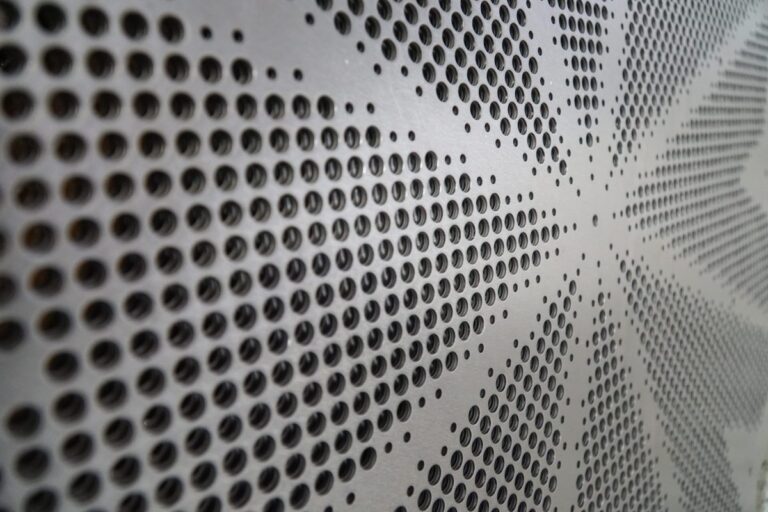🕑 Reading time: 1 minute
Acoustic metals are redefining how we design our cities—turning buildings and public spaces into active sound filters that can cut noise pollution without sacrificing aesthetics or structural integrity. Instead of relying on foam panels or fragile baffles, this innovation uses precision-engineered alloys embedded with microscopic chambers, tuned perforations, and sound-cancelling geometries. The result? Materials that not only look sleek and modern, but also reduce urban noise by up to 18 decibels, enough to make a chaotic street sound like a quiet park.
As cities densify and sound levels surge, especially from transit systems, construction, and vehicular traffic, acoustic metals are emerging as a game-changing tool for shaping healthier environments—both indoors and out. While traditional acoustic treatments wear down or require bulky installations, these metals are built to last, resist weather, and double as architectural elements—creating calm, elegant spaces in the middle of the urban storm.
What Are Acoustic Metals?
Acoustic metals are high-performance alloys engineered to interact with sound waves at the structural level. They combine:
- Micro-perforated skins to disrupt waveforms
- Helmholtz resonators built into the material core
- Phase-cancellation layers targeting specific frequencies
- Viscoelastic damping cores to suppress vibration
- Geometric diffusion surfaces that scatter sound energy
The result is a Noise Reduction Coefficient (NRC) of 0.65 to 0.85—rivaling soft acoustic panels but with none of the vulnerability to moisture, wear, or damage.
Lab tests show that structures using acoustic metals reduce perceived noise by the equivalent of doubling distance—meaning a loud street outside can sound like it’s 50 feet farther away.
Real-World Applications
Tokyo’s Acoustic Transit Corridor:
High-traffic transit hubs are a prime use case. Tokyo’s main rail concourse replaced concrete with acoustic aluminum panels, cutting peak noise from 82dB to 69dB—a noticeable 60% drop in perceived loudness. The panels also improved clarity of announcements, essential for navigation and safety.
Madrid’s Sound-Sculpted Plaza:
Here, acoustic steel columns and canopies form a public square that acts like a giant passive noise-canceller. It maintains ambient sound levels under 65dB even during rush hour, increasing average visitor dwell time by over 300%—a key signal of improved comfort.
Singapore’s Biophilic Soundscape Building:
This office complex uses zinc acoustic cladding that filters out mechanical noise while letting in natural sounds like birdsong and rainfall. It reduces external mechanical noise by 16dB while preserving a meaningful connection to the outdoor environment.
Advantages
- Durable in all weather — unlike foam or fabric-based treatments
- Dual purpose — structural and acoustic
- Tailored response — frequency-tuned for specific urban sound profiles
- Low maintenance — no degradation like soft materials
- Thermal and acoustic gains — improves both energy performance and sound quality
Considerations
- Higher upfront cost than conventional cladding
- Requires precise modeling and spectral analysis to tune effectively
- Needs specialized installation to ensure acoustic integrity
- Less effective in low-frequency ranges unless paired with resonant cavities
- Optimally used as part of an integrated acoustic strategy, not a standalone fix
FAQs
- Can it replace all other acoustic treatments?
Not quite. While it’s durable and high-performing, traditional soft absorbers still outperform it slightly at extreme high frequencies. However, in high-wear or outdoor environments, acoustic metals last 5–10x longer and deliver better ROI over time. - Is it really effective in loud urban areas?
Yes. Copenhagen’s harbor apartments documented interior noise reductions of 9dB from shipping activity using acoustic zinc cladding—a 50%+ drop in subjective noise perception, without bulky windows or barriers. - How is it customized for each location?
Projects like Melbourne’s Transit Hub record ambient sound data, analyze frequency patterns, then use computational models to design perforation layouts that cancel dominant noise sources. In one case, this boosted speech clarity by 35% in busy terminal areas. - Does it help with energy performance too?
Surprisingly, yes. Multi-layered acoustic metals interrupt thermal bridges and reduce solar gain, especially in aluminum versions. Barcelona’s Office Tower saw 12% lower cooling demand after retrofitting with acoustic cladding. - Most futuristic use so far?
London’s Adaptive Sculpture Network is leading the way. Each stainless-steel sound sculpture across noisy districts adjusts in real time based on ambient noise. Collectively, they’ve created 23dB drop zones for pedestrians walking through the city’s most chaotic streets—a living soundscape network embedded in the architecture.
[ad_2]
Source link


